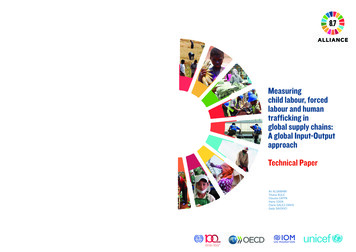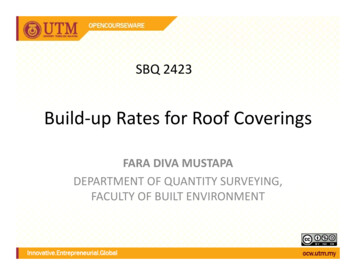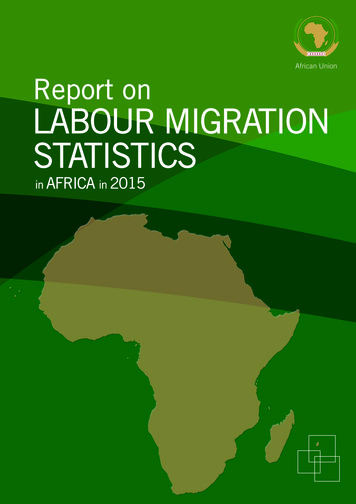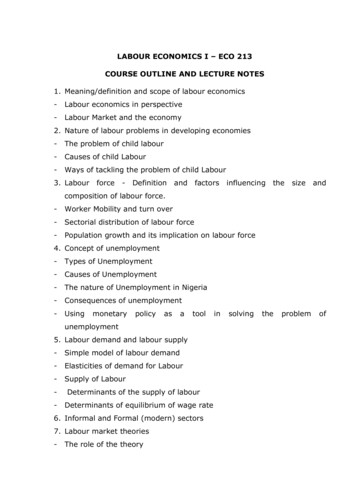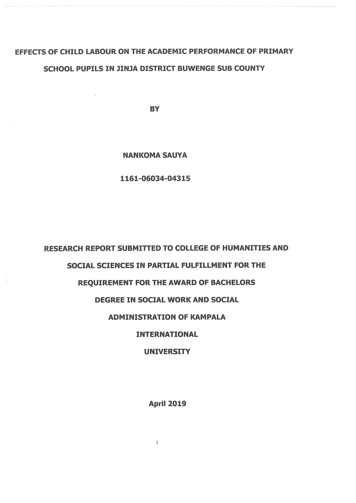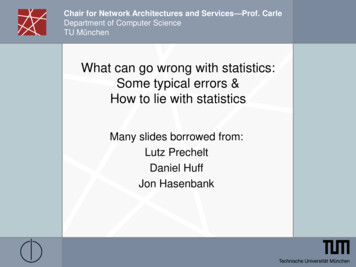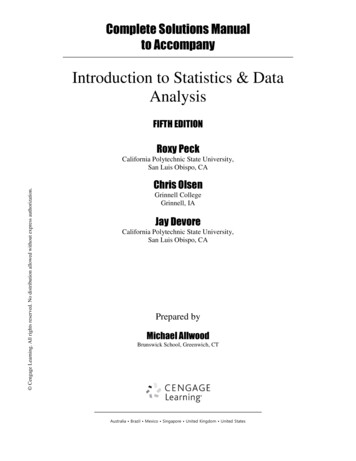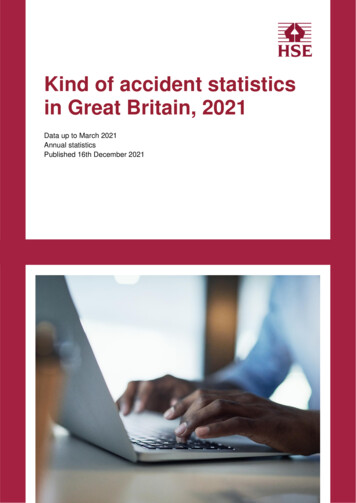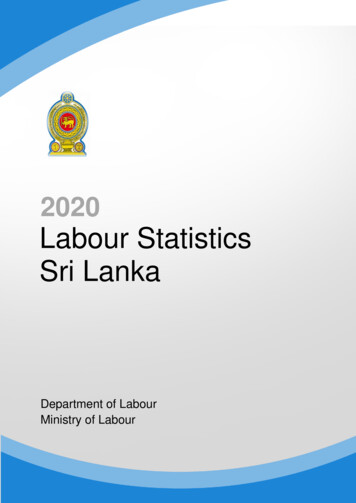
Transcription
2020Labour StatisticsSri LankaDepartment of LabourMinistry of Labour
Compiled byStatistics DivisionPublicationDepartment of Labour10th Floor, “Mehewara Piyesa”NarahenpitaColombo 05Tel / Fax: 94 011 2368055January 2022Printed byDepartment of Government PrintingColombo 08
Labour StatisticsSri Lanka2020Department of LabourMinistry of Labour
Labour Statistics 2020PREFACEThe labour statistics play a vital role in planning, decision making, monitoring and evaluation of thelabour activities as well as the manpower planning and labour administration. Besides, labour statisticsindicate the changes and behavioural patterns of the labour market of the country. All policymakersand planners in public and private sectors use labour statistics to plan their economic affairs andtherefore the demand for labour statistics has grown exponentially.Hence a publication on labour statistics is issued annually by the Department of Labour and “LabourStatistics 2020” is the 22nd publication in the series issued by the Statistics Division of the Departmentof Labour.The key labour statistics included in this publication consist of trend patterns in labour supply, thecomposition of labour force, the labour laws and regulations, the measures taken for the welfare ofemployees’ and the level of unemployment in the country.The Statistics Division of the Department of Labour, collects data from administrative recordsmaintained by various divisions of the Department of Labour, other Ministries, Departments andOrganizations to fulfil this requirement.Mrs Chandramali Premarathna, Deputy Director of the Labour Statistics Division of the LabourDepartment is responsible for planning and accomplishing this task with the assistance of the staff ofthe Statistics Division.I sincerely hope that this publication will meet the information needs of the labour sector and will beof great benefit to the users.Prabath ChandrakeerthiCommissioner General of LabourDepartment of LabourLabour SecretariatColombo 051i
Labour Statistics 2020ACKNOWLEDGEMENTThe publication of ‘Labour Statistics 2020’ provides multidimensional information on labour statisticsof Sri Lanka for 2020, based on the data pertaining to various institutions in this field.Firstly, I would like to convey my sincerest gratitude to the Commissioner General of Labour for hisvaluable guidance to complete this publication.I highly appreciate the support rendered by providing the required data accurately and timely by theCommissioners in the Department of Labour and the senior officials of the other respective Ministries,Departments and Institutions.I acknowledge the great work carried out by the Statistical officers, Mrs H E Wickramasuriya, Mr R MS Priyadarshana, Mr A A P Fernando, and Miss D M G I Dissanayake for data collection, verification,updating tables and figures, and preparing the publication. The supervision work conducted by theStatisticians, Mrs K A P Deepani and Mrs W A S Malkanthi is also appreciated very much. Meanwhile,I thank all other staff members of Labour Statistics Division for their fullest support given to completethis publication successfully.Further, I convey my thanks to the members of the publication committees of the Department ofLabour and the Ministry of Labour for their valuable guidance.I would be thankful if any valuable comments were given for the improvement of the next publicationin the future.Chandramali PremarathnaDeputy DirectorLabour Statistics DivisionDepartment of Labour10th Floor, Mehewara PiyesaColombo 05Tel / Fax: 94-011-2368055Email: labourst@sltnet.lk1ii
Labour Statistics 2020SUMMARY STATISTICSSummery Statistics on Demographic and Labour - 2020Estimated mid-year population21,919,000Registered Births301,706Crude Birth Rate13.8 (Per 000)Crude Death Rate6.0 (Per 000)Number of SchoolsNumber of PupilsNumber of Teachers11,0774,240,433264,781Number of Technical Colleges39New Admissions of Technical Colleges24,961Number of passed out graduates from Government Universities17,000International Net Migration93,862Employed PopulationUnemployed Population7,999,093467,513Labour Force Participation Rate50.6Employment Rate94.5Unemployment RateEmployed Population in Export Processing Zone EnterprisesDepartures for Foreign EmploymentMinimum Wage Rate IndexAverage Household Expenditure Per Month5.5130,59753,8754,281.94Rs. 63,130Number of Employees’ Contributing to the Employees’ Provident Fund89,853Number of Employers Contributing to the Employees’ Trust Fund75,756Number of StrikesNumber of Industrial Accidents30298iii 1
Labour Statistics 2020CONTENTSPAGEPREFACEiACKNOWLEDGEMENTiiSUMMERY STATISTICSiiiCONTENTSivLIST OF TABLESv-viiViiiLIST OF FIGURESCHAPTER TICSOFTHECHAPTER 2LABOUR FORCE PARTICIPATION26CHAPTER 3EARNINGS AND LIVING CONDITIONS44CHAPTER 4ENFORCEMENT OF LABOUR LAWS731iv 1
Labour Statistics 2020LIST OF TABLESCHAPTER 1TABLEPAGE1.1Population, Average Annual Growth Rate and Population Density by Districts,1981 and 201221.2Number of Sub National Administrative Divisions31.3Population by Sex and Sex Ratio for Census Years, 1911 – 201241.4Estimated Mid-Year Population in Sri Lanka by Sex, 2011 – 202051.5Estimated Mid-Year Population by District and Sex, 2016 – 202071.6Estimated Mid-Year Population by Sex and Age Groups, 2016 – 202081.7Registered Births by Sex, Crude Birth Rates and Crude Death Rates, 2011 – 202091.8Age Composition and Dependency Ratio in Census of Population 1971-2012101.9Population Literacy, 1971 – 2012111.10Literacy Rates by Sex and District (Population of Age 10 Years and Over) 1981 –2012121.11Literacy Rates by Age Groups and Sex (Population of Age 10 Years and Over)1990/91 – 2012131.12Education Statistics: No. of Schools, Teachers and Pupils, 2015 – 2020141.13Technical Colleges by Type, Number of Colleges, Students, Staff and Expenditure,2011 – 2020151.14Undergraduate Enrolment by University and Higher Educational Institute andMajor Courses of Study, 2013 - 2020161.15Undergraduate Admissions by University and Higher Educational Institute, 2013 2020211.15ANumber of Passed Out Graduates by State Universities, 2013-2020221.16AInternational Migration - Arrivals and Departures by Nationality, 2011 – 2020(Based on New Classification)231.16BInternational Net Migration by Nationality, 2011 – 2020241.17Projected Population by Standard, High and Low Projections, 1991 – 2031251v
Labour Statistics 2020TABLECHAPTER 2PAGE2.1Total Labour Force, Employed and Unemployed Population, 2011 – 2020272.2Household Population, Total Labour Force, Labour Force Participation Rate andUnemployment Rate, 2011 – 2020282.3Employed Population and Employment Rates by Gender, 2011 – 2020292.4Percentage Distribution of Currently Employed Persons by Employment Status,2011 – 2020302.5Percentage Distribution of Currently Employed Persons by Major IndustrialGroups, 2005 – 2012312.5APercentage Distribution of Currently Employed Persons by Major Industry Groups,2015- 2020322.6Distribution of Currently Employed Persons by Major Occupation Groups, 2011 –2020 Based on ISCO 08332.7Employment Statistics of Export Processing Zone Enterprises (As at end of 2020)342.8Percentage of Female Employees to Total Employees of Export Processing ZoneEnterprises (As at end of 2020)342.9Distribution of Public Employees by Sector and Year, 1980 –2016352.10Labour Force Participation Rate, Employment Rate and Unemployment Rate byGender, 2011 – 2020362.11Unemployed Population and Unemployment Rate by Gender, 2011 – 2020372.12Unemployment Rate by Province and Gender, 2016 – 2020382.13392.14Percentage Distribution of Unemployed Persons by Educational Attainment, 2011–2020Departures for Foreign Employment by Major Occupational Levels, 2011 - 20202.15Departures for Foreign Employment by Country, 2011 - 2020412.16Comparison of Male Migrant Workers with Housemaids and Other Female MigrantWorkers, 2011– 2020422.17Workers Remittances and Exports, 2011 – 20204340vi 1
Labour Statistics 2020CHAPTER 3TABLEPAGE3.1New Colombo Consumers' Price Index, 2017 – 2020453.2National Consumers' Price Index (NCPI), 2017 – 2020473.3Wholesale Price Index, 2011 – 2020483.4Minimum Wage Rate Index, 2011 – 2020493.5Wage Rate Index Numbers of Government Employees’ , 2016 – 2020503.6Annual Average of the Minimum Wage Rates for Tea and Rubber EstateWorkers and Primary Level Workers in Public Sector, 2010 - 2020513.7Annual Average of Minimum Rates of Wages, 2015 - 2020523.8Average of Minimum Wage Rates and Average Earnings by Sector, 2011 –2020683.9Household Size, Mean Household Income and Expenditure, 2005 – 2019693.10Average Monthly Household Income by Main Source of Income, 2005 2019693.11Average Household Expenditure Per Month by Major Expenditure Groups,2005 – 2019703.12Poverty Head Count Index by Districts, 1995/96 – 2016713.13Worker's Remittances as Foreign Exchange, 2011 – 202072CHAPTER 4TABLEPAGE4.1Enforcement of Labour Laws and Prosecutions, 2011 – 2020744.2Enforcement of Factory Ordinance, 2011 – 2020764.3Employees’ Provident Fund, 2011 – 2020774.4Receipt and Payment of Employee's Trust Fund, 2011 – 2020784.5Trade Unions, 2011 – 2020794.6Number of Strikes, Workers Involvement and Man-Days Lost, 2006 - 2020804.7Industrial Disputes, 2011 – 2020814.8Number of Industrial Accidents Reported and Compensation Paid, 2011 –2020824.9Number of Child Labour Complaints and Hazardous Child LabourComplaints, 2018 - 202083vii1
Labour Statistics 2020LIST OF FIGURESFIGUREPAGE1.1Population Density by Districts - 1981 and 201231.2Population and Sex Ratio for Census Years, 1911 - 201251.3Estimated Mid-Year Population by Sex, 2012 -202061.4Crude Birth Rate and Crude Death Rate, 2011 - 202091.5Dependency Ratio for the Population, 1971-2012101.6Literacy Rates for 1981 and 2012111.7Literacy Rates by Sex, 1971-2012121.8International Migration, 2011 - 2020241.9International Net Migration Pattern in Sri Lanka, 2011- 2020241.10Projected Population by Standard, High and Low Projections, 1991-2031252.1Total Labour Force and Employed Population, 2011 – 2020282.2Labour Force Participation and Unemployment Rates, 2011– 2020292.3Unemployment Rates by Sex, 2011 - 2020372.4The Level of Unemployment in Sri Lanka, 2011 -2020383.1Colombo Consumers' Price Index and Annual Rate of Inflation, 2017 – 2020463.2Index Number of Minimum Wages, 2011 -2020494.1E.P.F. Contribution and Surcharges, Amount Paid, and No. of EmployersContributing, 2011 - 2020774.2E.T.F. Contribution and Surcharges Received, Amount paid, 2011-2020794.3Number of Strikes and Man Days Lost, 2011-2020814.4Number of Industrial Accidents, 2011 - 2020824.5Hazardous Child Labour Complaints, 2018 - 2020844.6Child Labour Complaints, 2018 - 202084viii1
Labour Statistics 2020Chapter1SOCIO–ECONOMIC AND DEMOGRAPHICCHARACTERISTICS OF THE POPULATIONThe population of Sri Lanka was 20.36 milliondecade and new admissions to the technicalaccording to the Census of Population and Housingeducation have doubled in the period. Moreover,in 2012. The average annual population growthtotal expenditure on technical education wasrate was 0.7 percent according to this census and itincreased from 1,091.7 million rupees to 2,138.62was 1.2 percent in the Census of Population andmillion rupees in the period from 2011 to 2020.Housing in 2001. However, the average annualObserving statistics for University Education, thepopulation growth rate for the period of 1981-number2012 was 1.02 percent. The Sex Ratio (No. of malesgraduations have increased significantly. Theseper 100 females) has declined to 93.8 in the yearstatistics revealed a very optimistic picture about2012 though it was 99.2 in 2001. This imbalancedthe caliber of the skilled labour force in Sri Lanka.ofadmissions,enrollmentandgrowth of the population is not suitable to thedevelopment of the country. Although the averageannual population growth rate was declined in thelast intercensal period, the population density hasincreased from 230 to 325 within this 30 year andit was highest in Colombo district and lowest inVavuniya District.Furthermore, International Migrations (botharrivals and departures by nationality) haverapidly increased within the last decade. Due tovast majority which had gone abroad for foreignemployment till year 2015 to strengthen theeconomy of the country, the number ofdepartures of Sri Lankans have been higher thanA continuous progress of the education sector canthe number of arrivals. From 2015 the number ofbe seen in the past period and the number ofarrivals of Sri Lankans have been increasing.schools, teachers as well as the number ofstudents has increased annually since 2015. Theliteracy rate has been over 90 percent for bothsexes and no significant difference of the rateamong districts. A rapid improvement of technicalFinally, the proportion of the child population tothe working population (early dependency ratio)has been decreasing rapidly in the past period andit will adversely affect the society in the future.education sector can also be seen in the previous1
Labour Statistics 2020Table 1.1: Population, Average Annual Growth Rate and Population Densityby Districts, 1981 and 2012PopulationDistrictCensus 90,862AverageAnnualGrowth Rate1981-2012(Percentage)Population Density(Persons per Sq. Km.)Census 4717Matale357,354484,5310.98180248Nuwara 02230325KalutaraKandyKurunegalaSri LankaSource: Department of Census and Statistics- 1981 and 2012 Census of Population Reports(1) Jaffna and Kilinochchi data are given based on current district boundariesNote: Population Census 2012 was enumerated based on their places of usual residence. However, in allpreviouscensuses conducted up to 2001 were based on, where the persons were present at the census night2
Labour Statistics 2020Population per Sq.Km.Figure 1.1: Population Density by District, 1981 and m1610-255483-Anuradhapura22181-769411Nuwara strictDS/AGADivisionSub LabourOfficeTable 1.2: Number of Sub National Administrative 335276244116014,0214017Sri LankaSource: Department of Labour, Department of Census and Statistics3
Labour Statistics 2020There are 25 administrative districts in theCouncils (MC), Urban Councils (UC) andcountry and each administrative district hasPradeshiya Sabhas (PS). Pradeshiya sabhas arebeen divided in to divisional secretariat divisionsmainly established in rural areas and MCs andfor the administrative purposes under theUCs are mainly established in urban areas.decentralization. These divisional secretariatHowever, District and Sub labour office areasdivisions have been further sub divided in toare mainly demarcated according to the limits ofGrama Niladhari Divisions (made as a collectiondivisional secretariat divisions and one officeeither of smallest villages or, of a part of a largearea is consisted with several DS Divisionsvillage) and one officer called “Grama Niladhariwhereas several office areas are deviated from“was appointed for each division. In addition,existing boundry limits of divisional secretariatthe local government system is divided in todivisions.three different categories, such as MunicipalTable 1.3: Population by Sex and Sex Ratio for Census Years, 1911 - 2012Census 8.199.2201220,359.49,856.610,502.893.8Sex RatioSource: Department of Census and StatisticsThe table shows the population of Sri Lanka asheld on year 2012. Though the total populationrecorded at various censuses conducted fromhad been increased over the years continuously,1911 to 2012.The first Census of Sri Lanka wasthe sex ratio has declined steadily and it haslaunched in 1871. This census has reported thatstarted to drop sharply since 1946, indicating anthe population was 2.4 million, which hasexcess of the female population over the males.increased up to 20.36 million at the last census4
Labour Statistics 2020Figure 1.2: Population and Sex Ratio for Census Years, 1911 - Sex Population1963Sex Ratio1971198120012012Census YearTable 1.4: Estimated Mid-Year Population in Sri Lanka by Sex, 2011 - 11,24721,803*202010,61311,30621,919Source: Registrar General's Department– Statistics DivisionNote: The estimated mid-year Population until 2011 were based on the Census of Population and Housing 2001The estimation of mid-year Population from 2012 onwards were based on the Census of Population and Housing of 2012*ProvisionalTable 1.4 indicates the estimated midyearintercensalperiodpopulation by sex in Sri Lanka during theconsideringtheperiod of 2011–2020. Population data 5
Labour Statistics 2020Figure 1.3: Estimated Mid Year Population by Sex, 2012 - 202012,000Population ( ' 000 16201720182019*2020*FemaleThe above chart shows the estimated mid-yearpopulation by sex. The population hasgradually increased in the period from 2011 to2020 according to Census of Population in theyear 2012 for the estimations.However, the gender pattern has changed from2011 onwards according to the Census ofPopulation and Housing in 2012.6
Table 1.5: Estimated Mid-Year Population by District & Sex, 2016 - 2020 (000)2016(a)DistrictSri 218897432483224460252598466Source: Registrar General's Department* ProvisionalNote: (a) The estimation of midyear population from 2014 onwards were based on the final results of the Census of Population and Housing - 2012, and district level Figureswere based on the usual residence7Table 1.5 indicates the latest mid-year estimated population byGampaha were the first & second largest populated districts in Sridistrict & sex, for the period from 2016 to 2020. Colombo andLanka. The lowest population can be seen in Mullaitivu District.Labour Statistics 2020ColomboGampahaKalutaraKandyMataleNuwara laRatnapuraKegalleTotal2017(a)
Table 1.6: Estimated Mid-Year Population by Sex and Age Groups, 2016 - 2020 131,8639409231,8749469281,88595193410 - 889487415 - 388488920 - 179985225 - 280087230 - 585890735 - 673877840 - 271275045 - 466571950 - 262668655 - 453960560 - 6495544351296644851897545252398145552698645752965 - 6965929536466629836867230137167630337368030537570 - 7442918924043319124243819324544019424644319524875 & : Registrar General's Department8* ProvisionalNote: (a) The estimation of midyear population from 2014 onwards were based on the final results of the Census of Population and Housing – 2012.Table 1.6 shows the indicates the late estimated mid-year population by sex and age groups for the period from 2014 to 2018.A considerable improvement of the population canbe seen in every age group in the period of recent past.Labour Statistics 2020Total
Labour Statistics 2020Table 1.7: Registered Births by Sex, Crude Birth Rates and Crude Death Rates, 2011 - 2020Registered BirthsYearCrude BirthRate(Per 1,000Population)Crude Death Rate(Per .86.0Source: Registrar General's Department* ProvisionalNote: Number of births in a given year is the number of births registered in that particular yearTable 1.7 gives Registered Births by sex,females) in 2020. The highest number ofCrude Birth Rate and Crude Death Rate forbirths was registered in 2011. The Crudethe period from 2011 to 2020. Totalbirth rate has fluctuated from 17.3 to 13.8 inregistered births in 2011 were 362,044.this period and the crude death rate has(185,452 males and 176,592 females) and itincreased from 5.9 to 6.0 in this period.was 301,706 (154,068 males and 147,638Figure 1.4 : Crude Birth Rate and Crude Death Rate, 2011 - 2020Crude Rates (Per *2015*2016*201720182019*2020*Crude Birth RateCrude Death Rate9
Labour Statistics 2020Table 1.8: Age Composition and Dependency Ratio in Census of Population, 1971 - 9100.014,846100.00 – 144,94439.05,22615 - 597,20656.85384.2All Ages60 and 52012.476.1Dependency Ratio201265.448.3%60.2Source: Department of Census and StatisticsNote: (1) Census of Population was not conducted in 1991(2 ) Excluded Northern and Eastern Provinces in 2001 CensusThe child population of age below 15 (0-14 agerapidly declined from 39.0 percent to 25.2group) can be categorized as early dependencepercent, which is 14 units decrease in theand they are the future of a country. Butperiod of 1971 to 2012.unfortunately, this dependent population hasFigure 1.5: Dependancy Ratio for the Population, 1971 - 201280.0Dependency 12Census YearsTotal dependency ratio indicates the number ofDependency ratio was 76.1 percent in 1971 anddependents (age groups 0 - 14 years and elderlyit has gradually decreased until 2001 to 48.3age group 60 years and above) per 100 personspercent. However, it has gone up (60.2 percent)in the working age group 15 - 59 years. Thein 2012.10
Labour Statistics 2020Table 1.9: Population Literacy, 1971 - 2012YearPopulation 10 Years andOver ( In '000 95,7681990/91*(2)11,6741994*(3)Literates( In '000 )TotalLiterates 27,8418,30195.796.994.6Source: Department of Census and Statistics* Excluding Northern and Eastern Provinces(1) Census of Population 1971, 1981, 2001 and 2012(2) Household Income and Expenditure Survey 1990 / 1991, 2011(3) Demographic Survey – 1994A person who can both read and write withaged 10 years and over has increased up to 95.7understanding a short statement is consideredpercent during the last four decades. Literacyas a "Literate person". Table 1.9 provides therate of males is higher than that of femalesliteracy rates derived from previous censusesduringand other surveys for the period of 1971 toimprovement of the rate among females, can2012 by sex. The Literacy rate of the populationbe observed.theperiod.However,arapidFigure 1.6: Literacy Rates for Census Years, 1981 & 2012Year 1981Year rate95.7%This figure illustrates the gap between2012. It is clearly observed that the literateLiteracy and Illiteracy among population ofpopulation has increased in the previousaged 10 years and over for the year 1981 andperiod of thirty years due to free education.11
Labour Statistics 2020Literacy Rate (%)Figure 1.7: Literacy Rates by Sex, 1971 - 94All PersonsMale20012012FemaleTable 1.10: Literacy Rates by Sex and District (Population of Age 10 Years and Over),1981 - 87.2Sri 291.092.489.795.796.994.688.9Source: Department of Census and Statistics - Census of Population and Housing - 1981, 2001 and 2012* Excluding Northern and Eastern Provinces12
Labour Statistics 2020The table 1.10 shows the literacy rate by sexboth sexes, literacy rate of females hasand districts for the Census Years from 1981increased very rapidly than males. Thehighest literacy rate (98.5 percent) wasto 2012. The total literacy rate has increasedreported from Gampaha district and thefrom 87.2 percent to 95.7 percent in thesecond and third places were taken byperiod. Although, the rate has increased forJaffna and Colombo districts respectively.Table 1.11: Literacy Rates by Age Groups and Sex (Population of Age 10 Years and Over),1990/91 – 2012AgeGroup l Male Female Total Male Female Total Male 5.796.994.610 - 15 - 20 - 25 - 30 - 35 - 40 - 45 - 50 - 5479.189.769.186.3
4.8 Number of Industrial Accidents Reported and Compensation Paid, 2011 - 2020 82 4.9 Number of Child Labour Complaints and Hazardous Child Labour Complaints, 2018 - 2020 83 vii . Labour Statistics 2020 1 FIGURE LIST OF FIGURES PAGE 1.1 Population Density by Districts - 1981 and 2012 3
